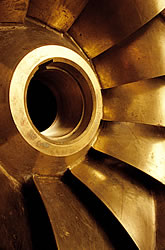Methods to reduce noise generated by fluid machines
Fluid machines like fans, pumps and IC engines can be found in many areas of modern industry. A substantial part of the noise these machines generate comes from fluid flow, which in most cases is simply the airflow that generates the sound. Flow generated noise is becoming an increasing problem, particularly fluid noise generated by fans. Fluid machines are connected to a duct or a pipe system trough, from which the sound can propagate before radiating to the surroundings via openings or wall vibrations. Consequently another important aerodynamic source of noise is the regenerated noise in flow ducts that imposes major limitations to the performance of compact flow systems. To increase the performance of fluid systems by increasing flow velocities while at the same time reducing weight requires a serious consideration of the flow generated noise. Increased flow velocities amplify the generated noise and change the sound transmission properties through the ducts of the machines. Unfortunately the physics problem of sound generation and transmission in fluid machinery systems had not been completely resolved. The acoustics theory of fluid machinery could not until now provide comprehensive predictive methods that will aid industries in achieving better acoustical designs. In order to improve the current knowledge of noise from fluid machinery systems, the current project has developed methods to model a non- linear source connected to a linear acoustic system so that propagation of sound at the connections of the machine with the pipe system can be treated correctly. Models of sound propagation from fans with non-ideal inflow conditions and from flow restrictions like orifices or bends have also been produced. The project has collected the aforementioned investigation and modeling in a “toolbox” protected by patents, which via a license agreement can be commercially exploited. The tools have already been successfully used by a number of industries, like Volvo for designing an IC-engine, by ABB for designing jetfans used for road tunnel ventilation and by Philips for hairdryers.

